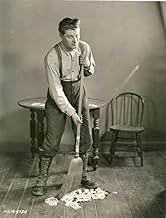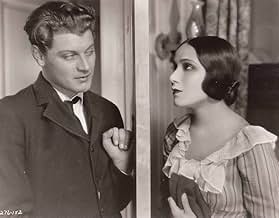Fortune hunters from all over the country rush to the Klondike in 1897 to seek their fortunes in the gold are tested by hardships of the journey.Fortune hunters from all over the country rush to the Klondike in 1897 to seek their fortunes in the gold are tested by hardships of the journey.Fortune hunters from all over the country rush to the Klondike in 1897 to seek their fortunes in the gold are tested by hardships of the journey.
- Awards
- 1 win total
Dolores Del Río
- Berna
- (as Dolores Del Rio)
Johnny Downs
- Mother's Boy
- (as John Down)
Josephine Adair
- Young Girl
- (uncredited)
Rita Claire
- Saloon Girl
- (uncredited)
Francis Ford
- Gold Commissioner's Assistant
- (uncredited)
- Director
- Writers
- All cast & crew
- Production, box office & more at IMDbPro
Storyline
Did you know
- TriviaDirector Clarence Brown called the film " . . . the hardest film I ever made." He was in charge of 2000 people in weather that was -60 F in 50-mph winds at 11,600-foot altitudes.
- ConnectionsEdited into Hollywood: The Dream Factory (1972)
- SoundtracksRed River Valley
(pub. 1896) (uncredited)
Traditional
Music by James Kerrigen
Played as background music
Featured review
Would you quit your job working on trains and commit, by what today might be considered, kidnapping and endangerment of a minor? Abandon your wife in Michigan? Abandon your entire family in Kansas? Stow away by train or ship? Abandon the dry gold fields of the Nevada desert--well, sure, who wouldn't do that.... To sail from San Francisco, to slog through the snowdrifts and mountain trails of the North, risk the rapids of the Yukon River, avalanches, freezing and starving to death, only to, then, fear fever, being assaulted, robbed and swindled, raped and forced into prostitution, eaten by dogs, or lit like a human torch... plus mosquitoes? I mean, yeah, gold is cool, but....
Set during the Klondike Gold Rush, "The Trail of '98" is more of an ensemble, rather than star-driven, late silent adventure epic that features a synchronized soundtrack of so-so sound effects and musical scoring (the sentimental lyrics for one smooching scene in particular was too much, and, at other moments, the constant blasts of wind can be grating). Indeed, it's a bit difficult and partly a wasted effort to try to keep track of all the characters--only some of whom ultimately drive the plot forward. The most important is the romance between Berna (early Mexican star Dolores Del Rio) and Larry, as threatened by the baddie Jack Locasto (Harry Carey, a star of Westerns with the moniker "Cheyenne Harry" early on, but who was transitioning to character roles by now). Larry teams up with some other prospectors in his pursuit for gold, but they're hardly worth mentioning and are only occasionally amusing.
It's no challenge to Charlie Chaplin's "The Gold Rush" (1925) as the best film made regarding Klondike yellow metal, but this one does feature some spectacular set pieces, visual effects and stuntwork, which, reportedly, included real-life casualties. The avalanche and fire scenes are especially grizzly, as is the wintry location shooting, and even the rear-projection photography for the rapids is relatively not too bad. On the other hand, there's far too much set-up, including excessive title cards, to get to the good stuff and even much of that is rudimentary, Victorian-style melodrama, while also resembling a wild-Northern Western. Most of the side characters and subplots aren't compelling enough to justify their inclusion.
The director here, Clarence Brown, could be a visually masterful filmmaker. He learned from one of the pioneers of cinematic visual innovation in Maurice Tourneur during the 1910s and into the early 1920s. He's, perhaps, best remembered for directing a few Greta Garbo vehicles, as well as pictures for other famous actresses, but some of them are remarkably lovely pictorially, and the romances are more effective than here, too. "Flesh and the Devil" (1926), in particular, is a masterpiece in these regards. I wonder what a filmmaker better adept at exploiting nature as a character could've done with this film, though--namely, Swedish émigrés Victor Sjöström or Mauritz Stiller, for instance. Or, perhaps, the blind character here could've been exploited to comment on the loss of visual virtuosity in the transition from silents to talkies, as was the flower girl in Chaplin's "City Lights" (1931), or even how blindness was associated with art by Yevgeni Bauer in "Za schastem" (1917). Instead, there is spectacle in "The Trail of '98" to see, but one need overlook the narrative dullness.
Set during the Klondike Gold Rush, "The Trail of '98" is more of an ensemble, rather than star-driven, late silent adventure epic that features a synchronized soundtrack of so-so sound effects and musical scoring (the sentimental lyrics for one smooching scene in particular was too much, and, at other moments, the constant blasts of wind can be grating). Indeed, it's a bit difficult and partly a wasted effort to try to keep track of all the characters--only some of whom ultimately drive the plot forward. The most important is the romance between Berna (early Mexican star Dolores Del Rio) and Larry, as threatened by the baddie Jack Locasto (Harry Carey, a star of Westerns with the moniker "Cheyenne Harry" early on, but who was transitioning to character roles by now). Larry teams up with some other prospectors in his pursuit for gold, but they're hardly worth mentioning and are only occasionally amusing.
It's no challenge to Charlie Chaplin's "The Gold Rush" (1925) as the best film made regarding Klondike yellow metal, but this one does feature some spectacular set pieces, visual effects and stuntwork, which, reportedly, included real-life casualties. The avalanche and fire scenes are especially grizzly, as is the wintry location shooting, and even the rear-projection photography for the rapids is relatively not too bad. On the other hand, there's far too much set-up, including excessive title cards, to get to the good stuff and even much of that is rudimentary, Victorian-style melodrama, while also resembling a wild-Northern Western. Most of the side characters and subplots aren't compelling enough to justify their inclusion.
The director here, Clarence Brown, could be a visually masterful filmmaker. He learned from one of the pioneers of cinematic visual innovation in Maurice Tourneur during the 1910s and into the early 1920s. He's, perhaps, best remembered for directing a few Greta Garbo vehicles, as well as pictures for other famous actresses, but some of them are remarkably lovely pictorially, and the romances are more effective than here, too. "Flesh and the Devil" (1926), in particular, is a masterpiece in these regards. I wonder what a filmmaker better adept at exploiting nature as a character could've done with this film, though--namely, Swedish émigrés Victor Sjöström or Mauritz Stiller, for instance. Or, perhaps, the blind character here could've been exploited to comment on the loss of visual virtuosity in the transition from silents to talkies, as was the flower girl in Chaplin's "City Lights" (1931), or even how blindness was associated with art by Yevgeni Bauer in "Za schastem" (1917). Instead, there is spectacle in "The Trail of '98" to see, but one need overlook the narrative dullness.
- Cineanalyst
- Oct 30, 2019
- Permalink
Details
- Release date
- Country of origin
- Language
- Also known as
- Gold
- Filming locations
- Denver, Colorado, USA(Gold rush scenes)
- Production company
- See more company credits at IMDbPro
Box office
- Budget
- $1,500,000 (estimated)
- Runtime1 hour 27 minutes
- Sound mix
Contribute to this page
Suggest an edit or add missing content






































